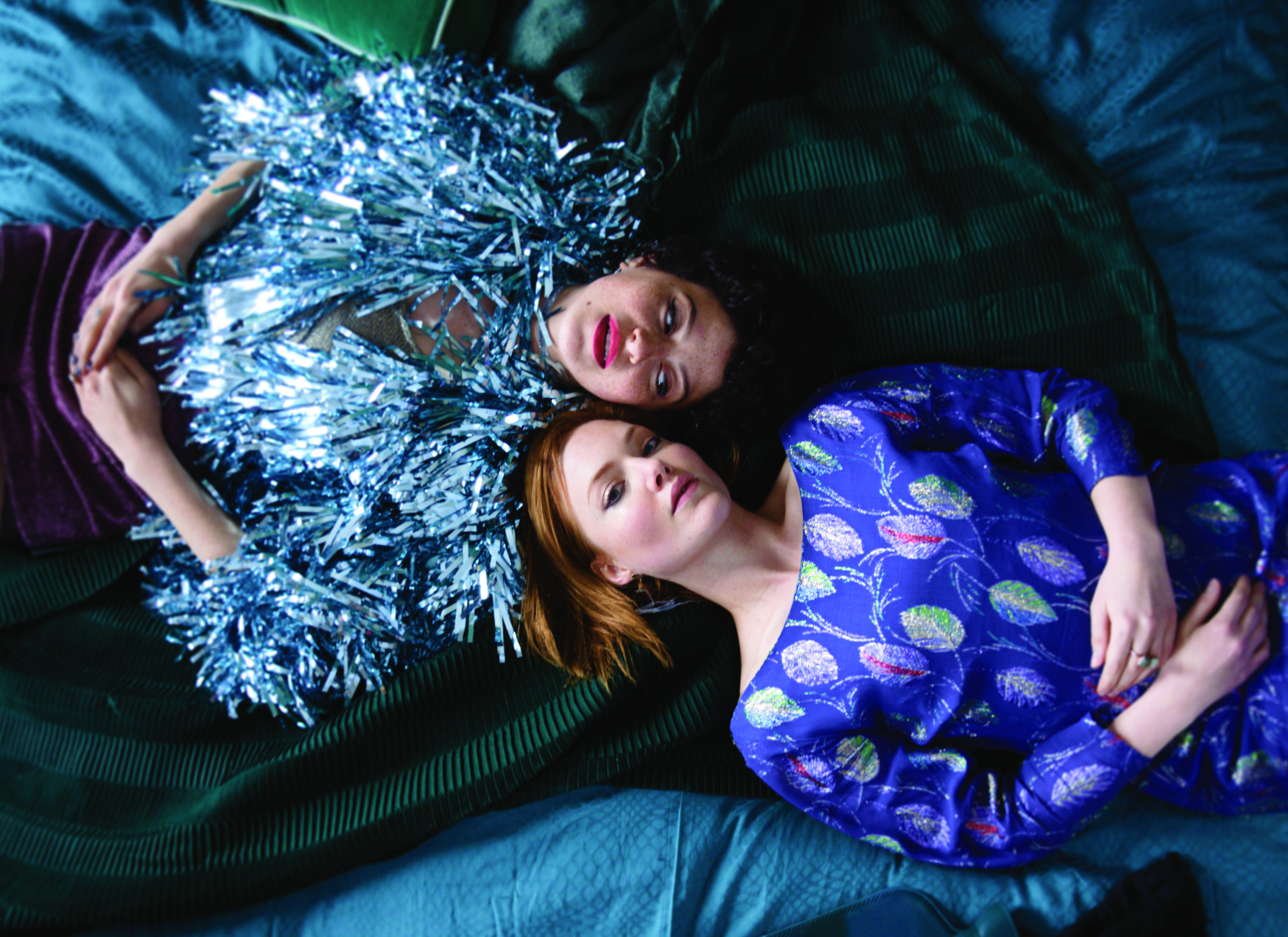Surrounded by racks of blisteringly white dresses, Tyler (Alia Shawkat) reaches for her sunnies and accepts the shop assistant’s offer of champagne. Her best friend, Laura (Holliday Grainger), is trying on potential wedding gowns – all pearls and lace, customarily virginal.
Laura shouts from the changing room, ‘It’s going to be a very modern wedding.’
Tyler rolls her eyes. Both women are a little bleary from cumulative weeks – months, years – of partying, yet they debate marriage’s contemporary value and significance with verve and assertiveness. Hedonistic Tyler believes the institution is, by definition, archaic and oppressive. Laura says her personal feminism is about ‘blazing a new way through old traditions’.
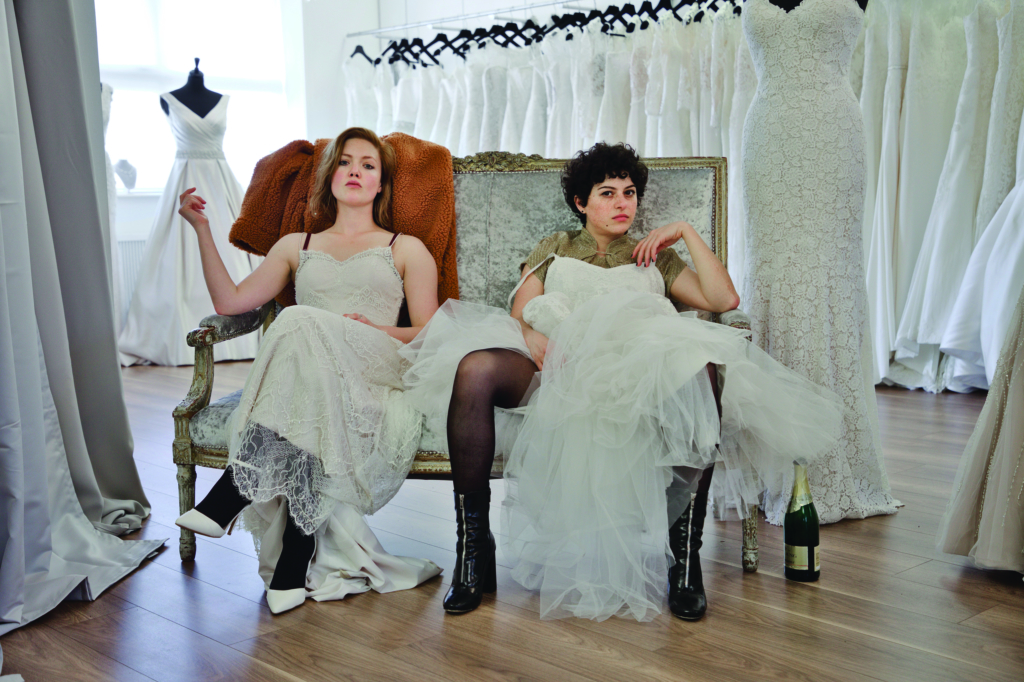
The push and pull of proximity
Animals (2019) is a story about evolution, if not revolution. Directed by Sophie Hyde and based on the book of the same name by Emma Jane Unsworth, it is also a fierce, heady film about women’s friendship. Animals explores the intimate but insecure bond shared by two millennial ‘dropouts’ living in Ireland. Gals about town, Tyler and Laura have been inseparable for a decade, but their desires and beliefs start to diverge when Laura proposes to her boyfriend, the (sober) concert pianist Jim (Fra Fee). Portraying decadence and decay in equal measure, Hyde’s film lays out the road map of heteronormative adulthood and asks, ‘But what if you choose to drive away from the sunset?’
With cinematic godparents in Withnail and I (Bruce Robinson, 1987) and Girlfriends (Claudia Weill, 1978), this bittersweet dramedy captures the overlapping modes of love that bud and wane between women. Partners in crime, Laura and Tyler squander the daylight hours working – or avoiding doing so – in call centres and cafes. They relish their nights together in bars and clubs, intimacy enhanced by alcohol and illicit substances. An American lone wolf in Dublin, Tyler has been adopted by Laura’s conventional nuclear family; she attends their fancy dinners out and plies the table with quotes by Ezra Pound.
The friends are also flatmates, nursing that unique closeness that comes from cohabitation. They share beds, bottles and tampons. The ostentatious id to Laura’s pensive superego, Tyler can look at a toilet bowl full of her bosom buddy’s urine and not bat an eye. On the topic of menstruation, she notes, ‘The Moon has married us both,’ their cycles now so in sync. But theirs are not the only nuptials on Laura’s horizon. Soon, Tyler will have to share her prized companion with someone else – of the male variety.
Laura meets the shy, retiring Jim while out on the tiles with Tyler. In an awkward but pivotal scene deftly handled by director and cast alike, sparks fly every which way. Laura is flirty, apparently attracted to Jim’s ‘enigmatic’ manner. Tyler, however, is outwardly distrustful – jealous, even – as she reads Jim’s shiny dress shoes and spotless white shirt for clues as to his intentions. Barely containing her disdain, she asks him, ‘What kind of person are you?’ At twenty-nine, she’s unimpressed by his early-to-bed, early-to-rise, homebody routine. But that’s precisely the kind of mature stability that Laura, at thirty-two, is learning to yearn for.
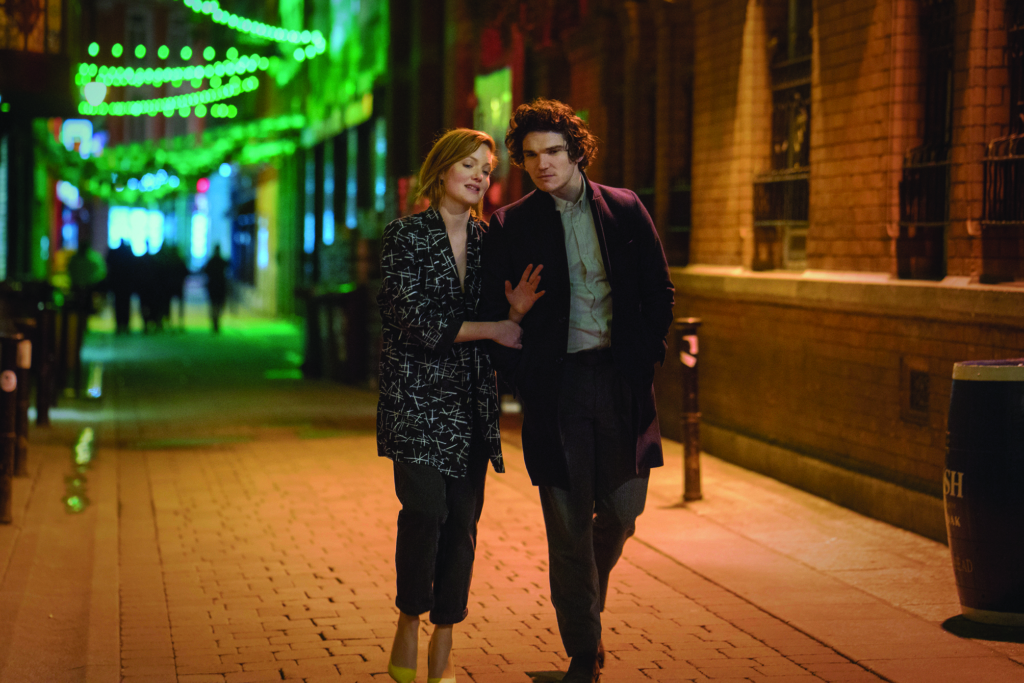
Outshone by a sister who’s married and having kids, Laura admires Jim’s dedication to his creative practice, and wants some of that for herself. Whereas Tyler boasts inspiration, Jim projects a quiet determination, the good influence needed for Laura to knuckle down and finish her novel about ‘a spider caught in its own web and the woman who rescues it’ (one of the many titular animals – including foxes, cats and fish – threaded through the film). To Laura, Jim represents the ‘food, sex and safety’ all animals need to survive.
Across the film’s narrative arc, Tyler and Laura’s love manifests in various guises, from platonic to romantic, familial to aspirational. Sometimes, it’s unconditional; sometimes, it’s unreciprocated; but it’s always complex and realistic. Shawkat and Grainger nail the sense of co-dependence inherent in many friendships. Habitually arm in arm, hand in hand, sitting and lying on each other, they’re fused physically as well as emotionally, almost as if each woman wants to become the other – a synthesis signposted in the opening montage, which is accompanied by Peaches singing, ‘The girls wanna be her. The boys wanna be her. I wanna be her. Yes, I do.’
But their enmeshment catalyses a string of repercussions: confusion, resentment, alienation and, paradoxically, loneliness. As Tyler grows desperate to ensure that their lives stay intertwined, her passionate extroversion only suffocates Laura. The stolen jar of MDMA that appears in scene after scene starts to stand in for an hourglass counting down to D-day. Each licked-and-dipped fingertip nudges Tyler and Laura’s youthful alliance closer to obsolescence. ‘[S]ometimes with friendships you need them to end and let go even though they’re beautiful and wonderful and worth celebrating,’ says Hyde.[1]Sophie Hyde, quoted in Walter Marsh, ‘Sophie Hyde on Animals, Nostalgia and Letting Friendships Die’, The Adelaide Review, 28 March 2019, <https://www.adelaidereview.com.au/arts/cinema/sophie-hyde-animals/>, accessed 19 May 2019. In this way, the dwindling jar becomes an affecting reminder that it’s okay to grieve for change, but that it isn’t something to be feared.
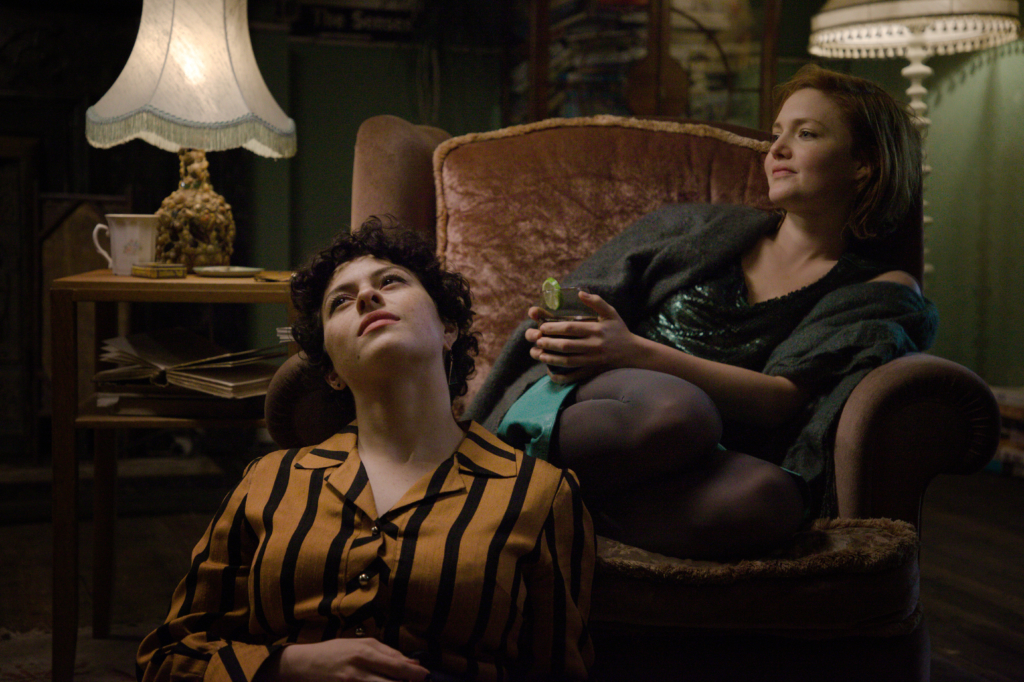
Women on and off screen
Produced by Dublin’s Vico Films and Adelaide’s Closer Productions, Animals is the first feature drama to have resulted from the Irish–Australian co-production treaty since it was signed in 1998.[2]‘Holliday Grainger and Alia Shawkat Star in Sophie Hyde’s Animals’, media release, Screen Australia, 22 March 2018, available at <https://www.safilm.com.au/pdfs/mr-180322-Animals.pdf>, accessed 19 May 2019. Best known for her Crystal Bear–winning feature debut, 52 Tuesdays (2013), and the six-part 2017 ABC TV series F*!#ing Adelaide, Hyde regularly examines gender, sexuality, family, performativity and social conditioning in her work. These same themes are interrogated in Animals with Hyde’s reliable lyricism, except this time she has enlisted actors with some bankable star power, thereby imbuing the film with broader commercial appeal than her previous titles.
Animals also marks Hyde’s first adaptation, with the director’s frequent writing partner Matthew Cormack – who co-scripted 52 Tuesdays, F*!#ing Adelaide and 2007 short film My Last Ten Hours with You – absent from the project. Unsworth collaborated with Hyde from the outset;[3]Marsh, op. cit. not only did she transport her text’s setting from its original Manchester to Dublin, but she also made some fundamental character and structural revisions in her screenplay. For instance, the book’s nonlinear narrative introduces Laura and Jim as already engaged in the opening chapter. In contrast, the film’s (mostly) linear structure means the audience gets to build rapport with and affection for Laura and Tyler as a closed, tight-knit team first, before Jim enters the picture and crimps their girl-power dynamic. Another crucial change is that Jean (Amy Molloy) is now Laura’s sister, not Tyler’s. With this visual and psychological reminder of her domestic onus to procreate now much closer to home, Laura’s introspective hero’s journey feels all the more pressing. Similarly, this narrative amendment further isolates the filmic Tyler – a stranger in a strange land, distanced from her American kin, relying on Laura for the unconditional love of a sister.
With its melange of witty humour and heartfelt angst, the film retains Unsworth’s vision through Tyler’s sardonic, often lewd one-liners and Laura’s bent for staring helplessly at a blank Word document. Snippets of prose and dialogue from the novel are woven into the film’s velvety textures via handwritten notes from Laura’s journal, shot in extreme close-up with a shallow depth of field, momentarily deleting the world beyond a writer’s interiority.
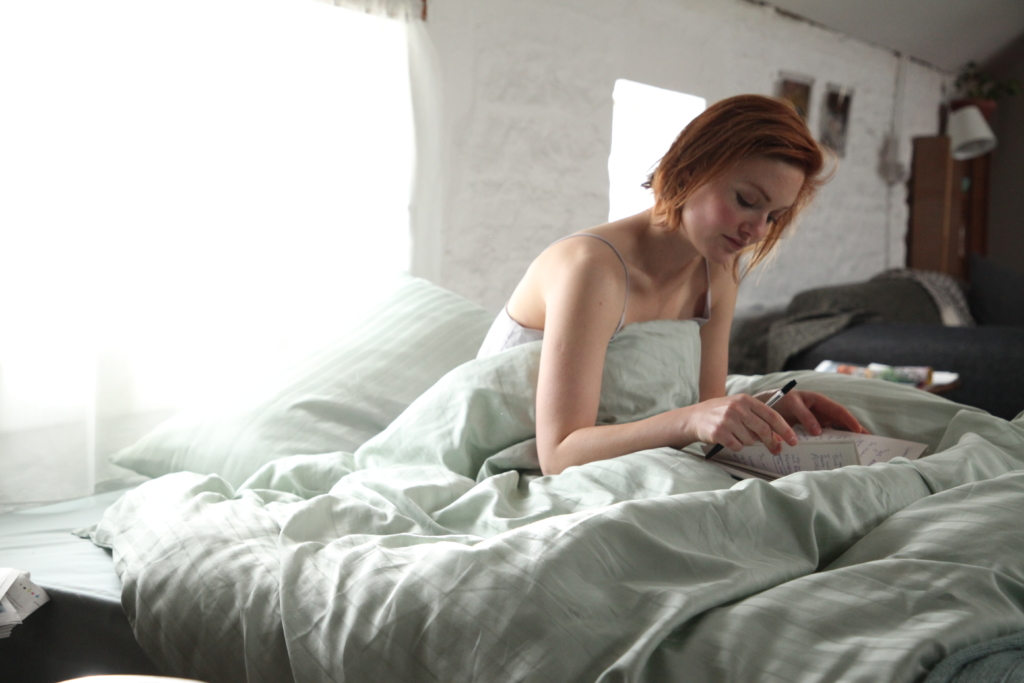
Unsworth and Hyde’s partnership aligns Animals with a gradual feminist upsurge on screens of all sizes over the past decade. In her analysis of the highest-grossing films of 2018, Martha M Lauzen – executive director of the Center for the Study of Women in Television and Film at San Diego State University – has found that male protagonists continue to dominate our screens, with women accounting for roughly just a third of major characters. Rates of representation for women of colour drop even further.[4]Martha M Lauzen, ‘It’s a Man’s (Celluloid) World: Portrayals of Female Characters in the Top Grossing Films of 2018’, Center for the Study of Women in Television and Film, San Diego State University, 2019, <https://womenintvfilm.sdsu.edu/wp-content/uploads/2019/02/2018_Its_a_Mans_Celluloid_World_Report.pdf>, accessed 19 May 2019. As Lauzen has outlined elsewhere, one potential cause for this dearth of female characters could be that women are also drastically underrepresented behind the camera, in both Hollywood[5]Martha M Lauzen, ‘The Celluloid Ceiling: Behind-the-scenes Employment of Women on the Top 100, 250, and 500 Films of 2018’, Center for the Study of Women in Television and Film, San Diego State University, 2019, <https://womenintvfilm.sdsu.edu/wp-content/uploads/2019/01/2018_Celluloid_Ceiling_Report.pdf>, accessed 19 May 2019. and American independent[6]Martha M Lauzen, ‘Indie Women: Behind-the-scenes Employment of Women in Independent Film, 2017–18’, Center for the Study of Women in Television and Film, San Diego State University, 2018, <https://womenintvfilm.sdsu.edu/wp-content/uploads/2018/07/2017-18_Indie_Women_Report_rev.pdf>, accessed 19 May 2019. filmmaking alike. On local shores, Screen Australia’s landmark Gender Matters report, which tracks women’s participation in domestic film production, has revealed that women accounted for just 30 per cent of producers, 21 per cent of writers and 16 per cent of directors working in feature filmmaking from 1970 to 2014.[7]Screen Australia, Gender Matters: Women in the Australian Screen Industry, November 2015, p. 5, available at <https://www.screenaustralia.gov.au/getmedia/f20beab8-81cc-4499-92e9-02afba18c438/Gender-Matters-Women-in-the-Australian-Screen-Industry.pdf>, accessed 19 May 2019. Damningly, the last figure has not risen since the 2015 release of Gender Matters.[8]In contrast, the participation rates for female producers and writers has increased to 34 and 24 per cent, respectively; see ‘Gender Matters KPI Update and New Industry Data Released’, media release, Screen Australia, 15 August 2018, <https://www.screenaustralia.gov.au/sa/media-centre/news/2018/08-15-gender-matters-kpi-update-and-new-data>, accessed 19 May 2019. Yet, in recent years, we have also seen increased fervour for the ‘strong female characters’ of films like Ocean’s 8 (Gary Ross, 2018) and Captain Marvel (Anna Boden & Ryan Fleck, 2019).[9]See, for example, Noah Berlatsky, ‘The All-female Ocean’s 8 Is Easily the Best Film of the Franchise. They Should’ve Ditched the Men Sooner.’, NBC News THINK, 8 June 2018, <https://www.nbcnews.com/think/opinion/all-female-ocean-s-8-easily-best-film-franchise-they-ncna881156>; and Angela Watercutter, ‘Captain Marvel Is About Female Power – Not Empowerment’, Wired, 11 March 2019, <https://www.wired.com/story/captain-marvel-is-about-female-power-not-empowerment/>, both accessed 20 May 2019. And although, according to Lauzen, female characters currently only make up 31 per cent of all blockbuster leads (up from 2017’s 24 per cent figure), this amounts to a ‘recent historical high’ in the number of profitable films headlined by women.[10]Lauzen, ‘It’s a Man’s (Celluloid) World’, op. cit.
Hyde cites TV series such as Desiree Akhavan and Rowan Riley’s The Bisexual as well as Ilana Glazer and Abbi Jacobson’s Broad City – both heavily female-centric titles – as Animals’ antecedents.[11]Marsh, op. cit. The film also parallels the Irish TV series Can’t Cope, Won’t Cope; this Dublin-set dramedy follows two twentysomething women – one an artist, one a corporate flunkey – contending with the discordant refrains of feminism, capitalism and tradition while trying to have a good time. Animals’ resonances with these stories is not by accident. With its female writer and director, several female producers as well as associate and executive producers, a strong contingent of women in creative roles, and two female lead actors, Animals – like its predecessors – exemplifies some necessary course corrections towards gender parity currently unfolding on screens and sets around the world.
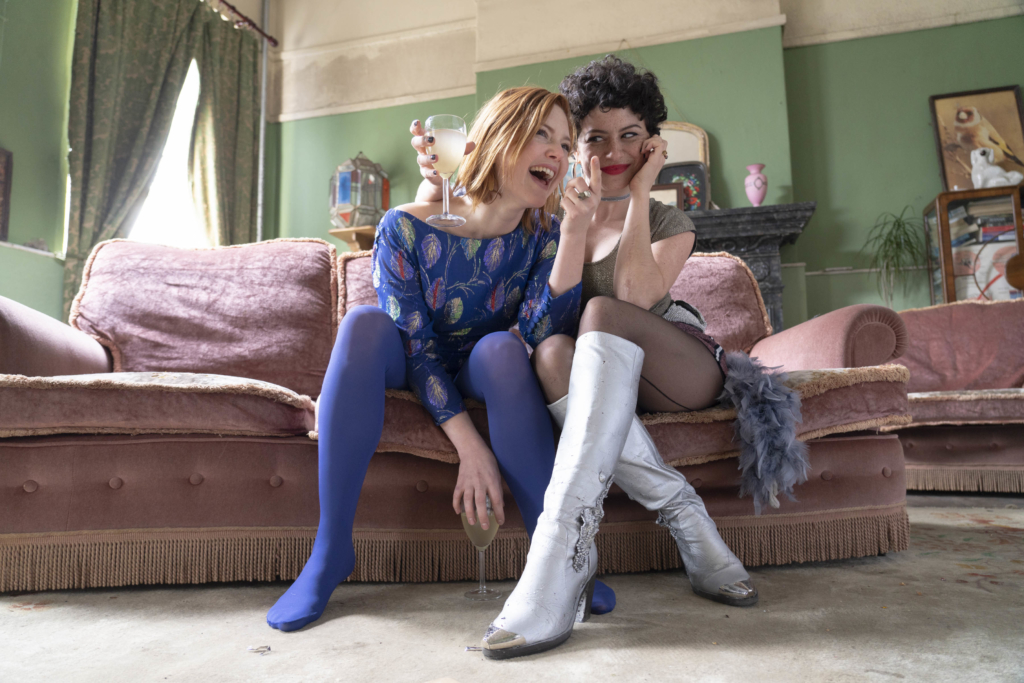
*
Animals is a film about love – a word that, coincidentally, is often used to describe the type of labour involved in indie filmmaking. It’s also a film about fear. Like many young women, Tyler and Laura are scared of an impending future, one that may or may not yield a career, marriage, children and/or family. They detour through the dread, suspicion and envy that pits women against one another on the race to tick off those milestones before the big 3-0 becomes a blip in their rear-view mirror. In the end, Laura must lean into her fear of instability. She annuls her engagement to Jim and graduates from her friendship with Tyler, stepping into a freer, more malleable land beyond coupledom. Tyler’s future is even more ambiguous. After some time apart, the former besties cross paths at Laura’s father’s birthday party, where Tyler’s presence suggests that she is still on good terms with the rest of her chosen family. With a new best friend – or possible girlfriend – in tow, Tyler appears to have moved on from her friendship with Laura. But whether she’s repeating her detrimental habits and behaviours is not revealed, leaving viewers in the same nebulous new world as the characters on screen.
Ultimately, Animals is a testament to women’s power and pleasure – and not just when attained through booze, sex, sequins and humour, even though these may be delightful indulgences en route to the larger goal. The same can be said of Hyde’s investment in the project, whose central storyline resonates with her own youthful past. ‘I felt like I was seeing these characters that felt very familiar to me, but I wasn’t seeing them much on screen,’ she recounts.
Women’s stories were being told in a certain way, and there was a bit of ‘girls behaving badly’, but there wasn’t a lot of depth underneath that – there’s a kind of moralising. I wanted to see something that felt so visceral and connected to my own experience.[12]Hyde, quoted in Marsh, ibid.
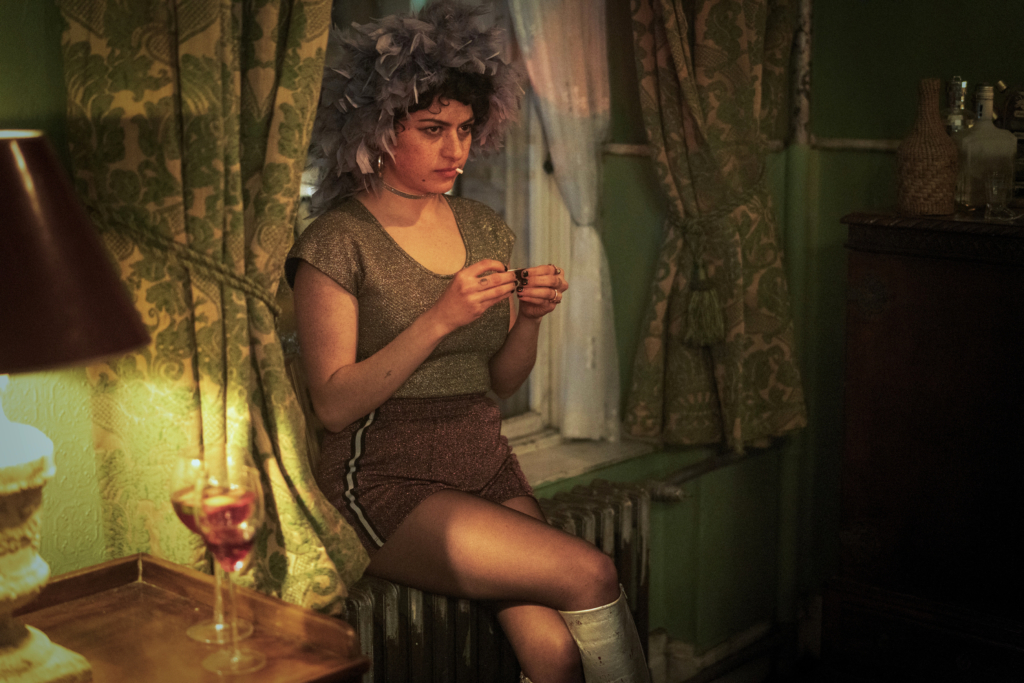
Animals suggests that no matter how hard we run, the surest route to joy involves filling your own bottle. More importantly, it reminds us that neither the hare nor the tortoise is ‘adulting’ wrong, so long as each eventually reaches its destination (and has a little fun along the way).
Endnotes
| 1 | Sophie Hyde, quoted in Walter Marsh, ‘Sophie Hyde on Animals, Nostalgia and Letting Friendships Die’, The Adelaide Review, 28 March 2019, <https://www.adelaidereview.com.au/arts/cinema/sophie-hyde-animals/>, accessed 19 May 2019. |
|---|---|
| 2 | ‘Holliday Grainger and Alia Shawkat Star in Sophie Hyde’s Animals’, media release, Screen Australia, 22 March 2018, available at <https://www.safilm.com.au/pdfs/mr-180322-Animals.pdf>, accessed 19 May 2019. |
| 3 | Marsh, op. cit. |
| 4 | Martha M Lauzen, ‘It’s a Man’s (Celluloid) World: Portrayals of Female Characters in the Top Grossing Films of 2018’, Center for the Study of Women in Television and Film, San Diego State University, 2019, <https://womenintvfilm.sdsu.edu/wp-content/uploads/2019/02/2018_Its_a_Mans_Celluloid_World_Report.pdf>, accessed 19 May 2019. |
| 5 | Martha M Lauzen, ‘The Celluloid Ceiling: Behind-the-scenes Employment of Women on the Top 100, 250, and 500 Films of 2018’, Center for the Study of Women in Television and Film, San Diego State University, 2019, <https://womenintvfilm.sdsu.edu/wp-content/uploads/2019/01/2018_Celluloid_Ceiling_Report.pdf>, accessed 19 May 2019. |
| 6 | Martha M Lauzen, ‘Indie Women: Behind-the-scenes Employment of Women in Independent Film, 2017–18’, Center for the Study of Women in Television and Film, San Diego State University, 2018, <https://womenintvfilm.sdsu.edu/wp-content/uploads/2018/07/2017-18_Indie_Women_Report_rev.pdf>, accessed 19 May 2019. |
| 7 | Screen Australia, Gender Matters: Women in the Australian Screen Industry, November 2015, p. 5, available at <https://www.screenaustralia.gov.au/getmedia/f20beab8-81cc-4499-92e9-02afba18c438/Gender-Matters-Women-in-the-Australian-Screen-Industry.pdf>, accessed 19 May 2019. |
| 8 | In contrast, the participation rates for female producers and writers has increased to 34 and 24 per cent, respectively; see ‘Gender Matters KPI Update and New Industry Data Released’, media release, Screen Australia, 15 August 2018, <https://www.screenaustralia.gov.au/sa/media-centre/news/2018/08-15-gender-matters-kpi-update-and-new-data>, accessed 19 May 2019. |
| 9 | See, for example, Noah Berlatsky, ‘The All-female Ocean’s 8 Is Easily the Best Film of the Franchise. They Should’ve Ditched the Men Sooner.’, NBC News THINK, 8 June 2018, <https://www.nbcnews.com/think/opinion/all-female-ocean-s-8-easily-best-film-franchise-they-ncna881156>; and Angela Watercutter, ‘Captain Marvel Is About Female Power – Not Empowerment’, Wired, 11 March 2019, <https://www.wired.com/story/captain-marvel-is-about-female-power-not-empowerment/>, both accessed 20 May 2019. |
| 10 | Lauzen, ‘It’s a Man’s (Celluloid) World’, op. cit. |
| 11 | Marsh, op. cit. |
| 12 | Hyde, quoted in Marsh, ibid. |
